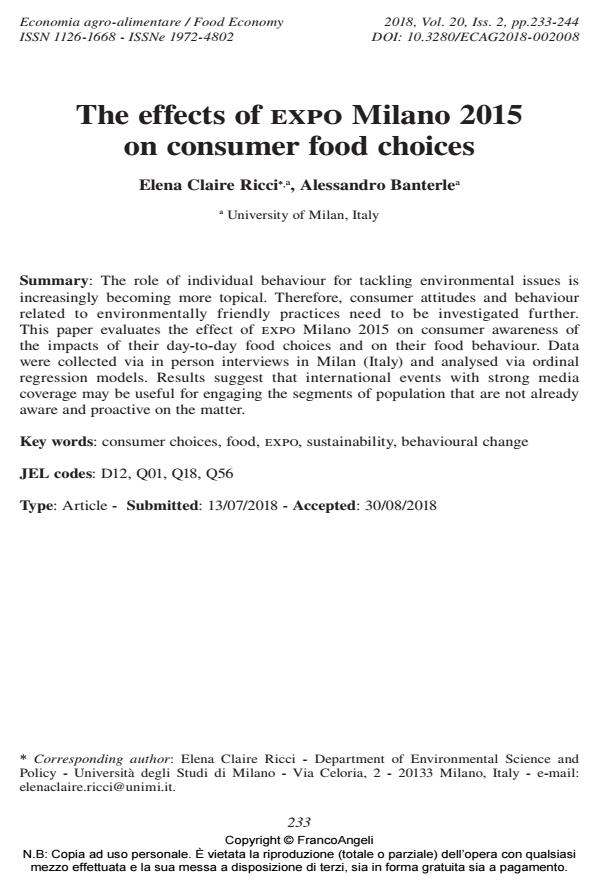The effects of expo Milano 2015 on consumer food choices
Journal title ECONOMIA AGRO-ALIMENTARE
Author/s Elena Claire Ricci, Alessandro Banterle
Publishing Year 2018 Issue 2018/2
Language English Pages 12 P. 233-244 File size 113 KB
DOI 10.3280/ECAG2018-002008
DOI is like a bar code for intellectual property: to have more infomation
click here
Below, you can see the article first page
If you want to buy this article in PDF format, you can do it, following the instructions to buy download credits

FrancoAngeli is member of Publishers International Linking Association, Inc (PILA), a not-for-profit association which run the CrossRef service enabling links to and from online scholarly content.
The role of individual behaviour for tackling environmental issues is increasingly becoming more topical. Therefore, consumer attitudes and behavior related to environmentally friendly practices need to be investigated further. This paper evaluates the effect of expo Milano 2015 on consumer awareness of the impacts of their day-to-day food choices and on their food behaviour. Data were collected via in person interviews in Milan (Italy) and analysed via ordinal regression models. Results suggest that international events with strong media coverage may be useful for engaging the segments of population that are not already aware and proactive on the matter.
Keywords: Consumer choices, food, expo, sustainability, behavioural change
Jel codes: D12, Q01, Q18, Q56
- Possibilities to improve the image of food and organic products on the AP Vojvodina market by introducing a regional quality label Jelena Končar, Aleksandar Grubor, Radenko Marić, Goran Vukmirović, Nenad Đokić, in Food and Feed Research /2019 pp.111
DOI: 10.5937/FFR1901111K - Word Food Day on Twitter 2009-2020: Driven by UNFAO and Aligned Campaigns Michael Thelwall, in SSRN Electronic Journal /2021
DOI: 10.2139/ssrn.3807861 - Food Loss and Waste, a global responsibility?! Nino Adamashvili, Filomena Chiara, Mariantonietta Fiore, in ECONOMIA AGRO-ALIMENTARE 3/2020 pp.825
DOI: 10.3280/ECAG2019-003014
Elena Claire Ricci, Alessandro Banterle, The effects of expo Milano 2015 on consumer food choices in "ECONOMIA AGRO-ALIMENTARE" 2/2018, pp 233-244, DOI: 10.3280/ECAG2018-002008